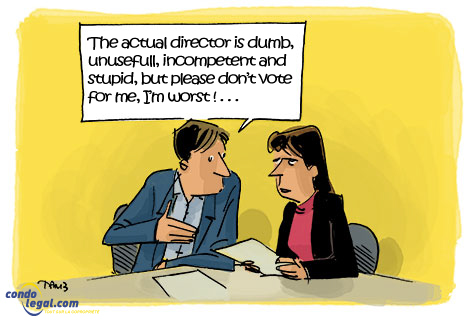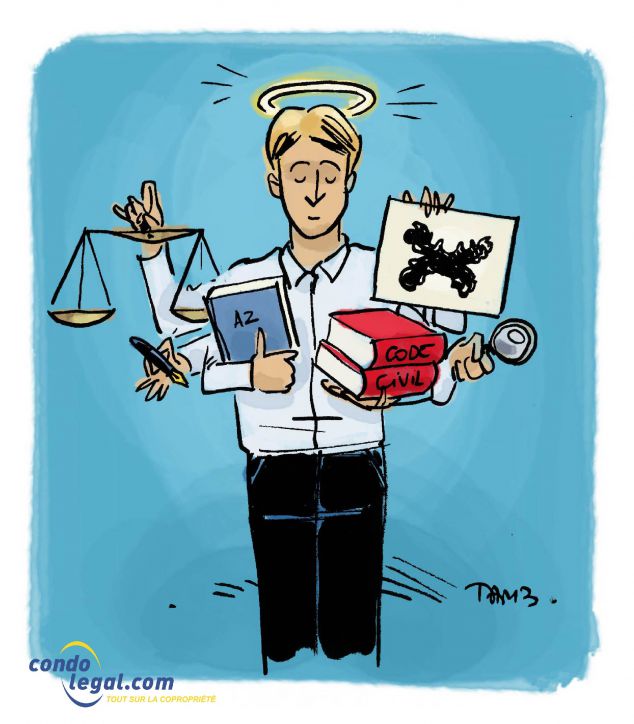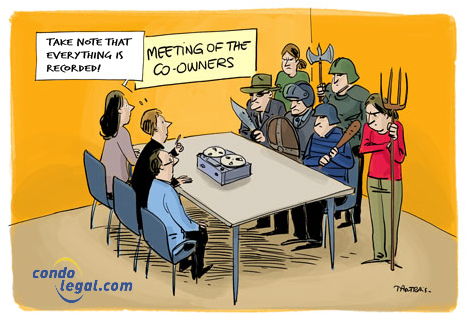
The Board of Directors (the Board) is made up of members called directors. Their appointment is subject to certain formalities. In this regard, article 1084 of the Civil Code of Québec provides that the composition of the Board of the syndicate, the method of appointment, replacement or remuneration of the directors, as well as the other terms and conditions of their office, are fixed by the by-laws of an immovable. Each director acts as a mandatary of the syndicate of co-owners. This person must comply with the obligations imposed on him by law and the constituting act of co-ownership and act within the limits of the powers conferred on him.
Functions on the Board of Directors
The directors may determine among themselves their functions and in particular designate a president, a vice-president, a secretary and a treasurer. This way of proceeding is determined by the by-laws of the immovable. It should be noted that the President of the Board organizes and directs the work of the Latter, which he reports to the Meeting of co-owners. In particular, it ensures that the directors are able to fulfil their mission. While there is no winning recipe for determining what a good president is, this position nevertheless requires some knowledge, experience and tactful authority. Beyond the direction that the debates will take, the President must be an excellent moderator.
As for the Vice-president, the latter is the person designated to take the direction of the board of directors when the president cannot exercise it. It is desirable that the Vice-President should not limit himself to this role of substitute. Efficient work requires a good division of labour between President and Vice-President.
The Secretary's duties are generally to send notices of meetings of the Board of Directors, and to draw up minutes of the deliberations and decisions of this decision-making body. He performs any other function (in connection with his activities) that the Board of Directors requires him to assume.
Usually, the treasurer establishes or has established, under his responsibility, the accounts of the co-ownership. He thus ensures the implementation of accounting audits and the appropriate keeping of the accounts of the syndicate of co-owners. The Treasurer is also responsible for updating and maintaining accounting records. This office usually includes the preparation and monitoring of the budget forecast, the updating of the bank account and the management of the sums held in the contingency fund and the self-insurance fund with the financial institutions, and that of investments and financing.
Number
The number of directors on the Board varies according to the needs of the co-ownership. It is the by-laws of immovable that determines the number of directors. This may be revised upwards or downwards by the meeting of co-owners following a vote amending the by-laws of an immovable.
This number varies depending on the size of a co-ownership. The larger it is, more directors are appointed. It is preferable to have an odd number of directors. Although there is no obligation in the Law in this regard, this approach limits the risk of deadlock during the decision-making process. That being said, is not full proof since it does not resolve the occurrences where a director is absent or abstains from voting.
Interim director
In a newly built immovable, the administration is provided for a certain period by a interim director. Appointed by the developer to act as the first director of the syndicate, he exercises the functions of the Board of directors from the publication of the declaration of co-ownership. His mandate ends with the election of a new Board of Directors, to be held at the Special Transitional Meeting.
Sole director
In co-ownerships comprising three apartments or less, the most common formula used is that of a sole director. This approach is very often criticized, because it comes down to entrust the destiny of the co-ownership to a single person, who most of the time is a co-owner. The potential for conflict related to the decision-making process and to the internal management of the co-ownership is enormous. In order to counter this concentration of power in the hands of a single individual, some co-ownerships prefer that one director per dwelling unit be appointed.
Co-ownership by phases
In co-ownerships built in phases, it is common for the initial declaration of co-ownership, which governs all the co-owners, to provide that the Board (of the initial co-ownership) be made up of a director appointed by each of the syndicates of co-owners resulting from a concomitant declaration of co-ownership. Thus, each co-ownership can be represented by a person chosen, generally, among the directors of each of the concomitant co-ownerships.
Mixed use co-ownership
The composition of the Board in mixed-use co-ownerships is often governed by a special clause: the co-owners of commercial units have the prerogative of designating at least one or more directors to the Board. This ensures them a minimum level of representation on the Board.
 WHAT YOU SHOULD KNOW! Directors play a key role in the sound management of the co-ownership. They must therefore be chosen carefully. The general meeting of co-owners usually has the task of appointing them.
WHAT YOU SHOULD KNOW! Directors play a key role in the sound management of the co-ownership. They must therefore be chosen carefully. The general meeting of co-owners usually has the task of appointing them.
 WHAT TO KEEP IN MIND: To limit the risk of the Board being dead locked, because of a division of votes favoring its almost systematic stalemate, the by-laws of the immovable should provide for an odd number of directors.
WHAT TO KEEP IN MIND: To limit the risk of the Board being dead locked, because of a division of votes favoring its almost systematic stalemate, the by-laws of the immovable should provide for an odd number of directors.
 WARNING! The Board can only be composed of natural persons, whether they are co-owners or not in the immovable.
WARNING! The Board can only be composed of natural persons, whether they are co-owners or not in the immovable.
Back to the mega-factsheet Board of Directors


